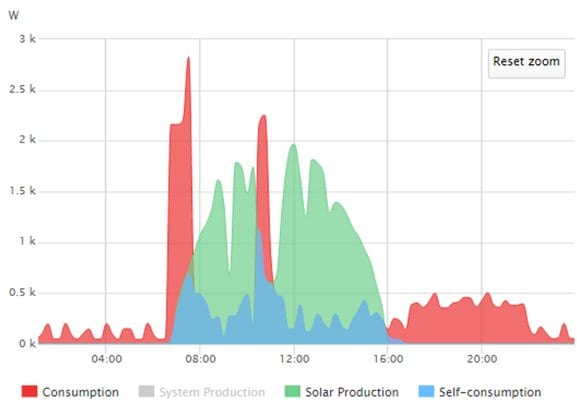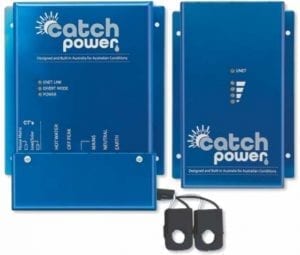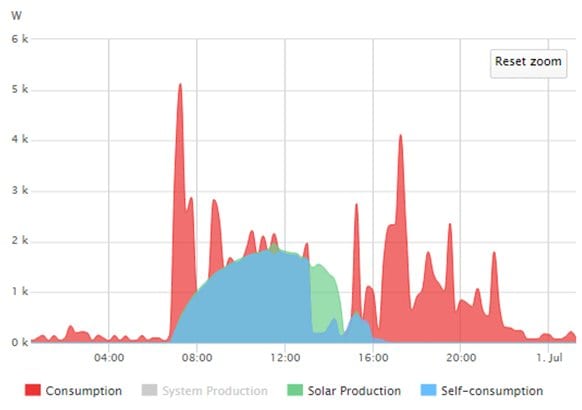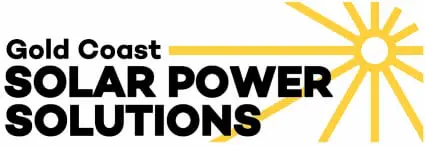The Solar Immersion brand is no longer available, however, better products are!
Maximise the self-consumption of your solar power with solar immersion devices from Catch Power
 Solar immersion units such as the products from Catch Power are a great, cost-effective way to utilise your surplus solar power. With the price that electricity retailers pay you for surplus solar power these days being between 4c to 10c per kWh and the price we pay for power being around 23c a kWh it just doesn’t make sense to send surplus power back to the grid if you can help it. The problem we have is a typical home has daily power consumption and solar production graphs that look something like the below.
Solar immersion units such as the products from Catch Power are a great, cost-effective way to utilise your surplus solar power. With the price that electricity retailers pay you for surplus solar power these days being between 4c to 10c per kWh and the price we pay for power being around 23c a kWh it just doesn’t make sense to send surplus power back to the grid if you can help it. The problem we have is a typical home has daily power consumption and solar production graphs that look something like the below.
Typical Power Consumption & Solar Production Graph – Note lots of Surplus Solar Power!

With the above graph you can see the following:
Red shaded area representing power which has been taken from the grid at a cost of 23c a kWh.
Blue area is self-consumed solar power which is what we want, that is saving us from taking power from the street at 23c a kWh.
Green is surplus solar power; this is solar power that has been generated but hasn’t been used so it has been sent back to the street as surplus solar power at 4c to 10c a kWh, depending on rates paid by your electricity retailer.
With this system we actually put a timer on the hot water system with a 1.8kW element to try and maximise solar self-consumption; that’s the big spike in power you can see at around 10 am. On this particular day, the plan backfired quite badly as 10 am happened to be right when a cloud came over and caused a big drop in solar power production, causing most of the hot water to be heated from the grid at 23c a kWh – exactly what we are trying to avoid.
To really maximise the self-consumption of solar power we want something that monitors exactly how much surplus solar power there is and then puts that amount of power to use, and that is exactly what the Solar Immersion device does.
How Catch Power Solar Immersion devices helps you use your surplus solar power
 The solar immersion device such as a Catch Power connects to your hot water system as well as the mains cables coming in from the street. It monitors the power coming from the grid as you consume power and it also monitors any power going back to the grid as surplus when your solar power system is producing more power than you’re using. What it will do is see exactly how much surplus solar power you have available and it will send exactly that amount of power to your hot water system.
The solar immersion device such as a Catch Power connects to your hot water system as well as the mains cables coming in from the street. It monitors the power coming from the grid as you consume power and it also monitors any power going back to the grid as surplus when your solar power system is producing more power than you’re using. What it will do is see exactly how much surplus solar power you have available and it will send exactly that amount of power to your hot water system.
Effectively what the system is doing is using your hot water cylinder as a device to store surplus solar power, a lot like a battery. It stores this surplus solar power effectively as hot water and then you can draw from it at a later time as required.
Solar Immersion Power Consumption & Solar Production Graph – Note Solar Power Self Consumption!

In the above graph you can see the same solar power system as previously shown but this time with the Catch Power Green Catch Solar Immersion device fitted. The thing that’s immediately obvious is just how much more solar power self-consumption has been achieved! You can see how the Catch Power device has sent all the surplus solar power to the hot water system until about 2 pm; by that time the water was up to temperature and the thermostat turned the system off, with the remaining surplus solar power being sent back to the grid.
You can see how the Catch Power device has sent all the surplus solar power to the hot water system until about 2 pm; by that time the water was up to temperature and the thermostat turned the system off, with the remaining surplus solar power being sent back to the grid.
Solar immersion devices – a great way to maximise your self-consumption of solar power
As can be seen, solar immersion devices like the Green Catch are a great way to maximise your solar power self-consumption and work out to be much cheaper than even a very small battery bank when it comes to storing surplus solar power. The next question to ask is how much surplus solar power can you actually store in your hot water system? The answer will depend on 2 factors – the size of your hot water system and the temperature that the water needs to be heated to.
Power required to heat hot water cylinders of various sizes by 40oC
Please note: A typical household uses around 40–50 litres of hot water per person per day.
Tank Capacity (Litres) |
Power Required (kWh) |
| 100 | 4.67 |
| 150 | 7.00 |
| 200 | 9.33 |
| 250 | 11.67 |
| Capacity of Tesla PowerWall Battery | 13.5 |
| 300 | 14.00 |
| 350 | 16.33 |
| 400 | 18.67 |
 From this table a standard home hot water system can easily store more surplus solar power than a battery bank such as the Tesla PowerWall and at a fraction of the cost! Why not contact Gold Coast Solar Power Solutions to see if a Catch power solar immersion device is right for you today?
From this table a standard home hot water system can easily store more surplus solar power than a battery bank such as the Tesla PowerWall and at a fraction of the cost! Why not contact Gold Coast Solar Power Solutions to see if a Catch power solar immersion device is right for you today?
Got A Question About Solar Power? Click Here For Answers!
- Can you add more solar panels to your solar power system?
- How much power can you expect from your solar power system?
- Do you know how to read your Energex solar power meter?
- How to make the most of the 44c feed in tariff
- How to make the most of a low solar feed in tariff

